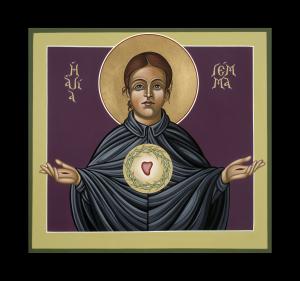Sale on canvas prints! Use code ABCXYZ at checkout for a special discount!

Saint Gemma Galgani
by John D. Dadosky
From the book ”Image to Insight” UNM Press 2018
Gemma Galgani (1878–1903) was born on
March 12, 1878, in the village of Lucca in
Italy. She lost her beloved mother at the age of
seven. Gemma’s life is characterized by what in
Eastern Christianity is called a podvig—a soul that
suffers spiritually or carries a heavy burden, not for
needless martyrdom but for the sake of others.
She was a mystic who experienced supernatural
visions and physical infirmities. There were some
who persistently questioned the authenticity of
her experiences. At one point she nearly died as a
result of meningitis and was healed, she claimed,
as a result of her intercession to St. Gabriel Possenti
(1838–1862). The latter was a member of the
Passionist community, a community that became
very attractive to Gemma because she identified
with their charism, which focuses on the passion,
suffering, and death of Jesus Christ. She lived a
quiet life, but her interior life was quite active. A
pleasant, quiet, and beautiful young woman, she
refused marriage proposals because she insisted
that she was to be the spouse of Christ. She eventually
received the stigmata, or mystical wounds
of Christ. The wounds would appear on Thursday
evenings and would last for a couple days while she
underwent periods of ecstasy. Afterward she would
return to her normal life.
She died of tuberculosis on April 11, 1903,
during Holy Week. The priest attending her
deathbed reported that she died with a smile on
her face. She was canonized a saint in 1940. Her
feast day is April 11.
Gemma Galgani lived a relatively short life,
but as with many of the saints, her actual temporal
life was like a seed from which an intergenerational
significance sprang forth. The legacy
of these saints persists and accumulates over
generations, and people recognize many things
they can identify with in the saints. In Gemma’s
case her life was quite unique and was filled with
mystical experiences of the passion of Christ.20
There is a certain paradox in Gemma’s life:
while she longed to join the Passionist religious
order during her life, she was prevented from
doing so due to complex circumstances. When
St. Gabriel Possenti appeared to her during her
sickness, she claimed he told her that she was a
Passionist, indicating that it was not necessary for
her to officially join the order. Even though she
never formally became a Passionist in her life time,
today the order claims her as a saint. In this way,
Gemma stands for all of those who feel deeply that
they have vocations in the church but do not have
official or former avenues in order to express them.
Gemma’s vocation matches one of the key teachings
of Vatican II: true communion occurs primarily
according to internal and not external criteria.21
The inspiration for this image was a picture
of Our Lady holding her hands out in prayer at
Pentecost. This image enabled Bill to show the
wounds of the stigmata. The colors reflect the
season of Lent, and she wears the black of a Passionist
habit. Her heart is surrounded with the
crown of thorns, which reflects the spirituality of
the Passionists in their motto: “May the Passion
of Christ always be in our hearts.” It also reveals
the truth of such suffering—the expanding heart
of mercy and compassion.
Because of her experience of the spirituality
of the passion, she was important for Bill during
his work in the 1980s with people with AIDS. He
interceded to her on behalf of many of the victims
to whom he ministered.